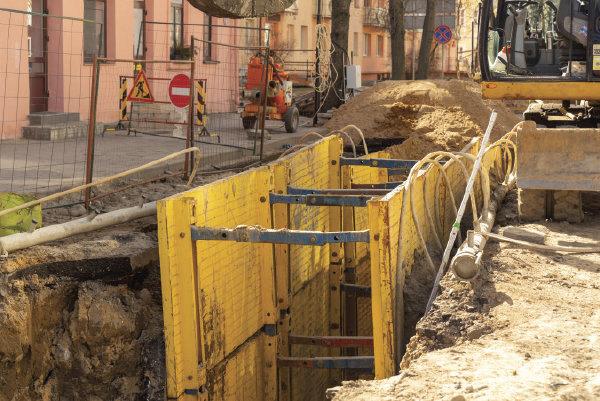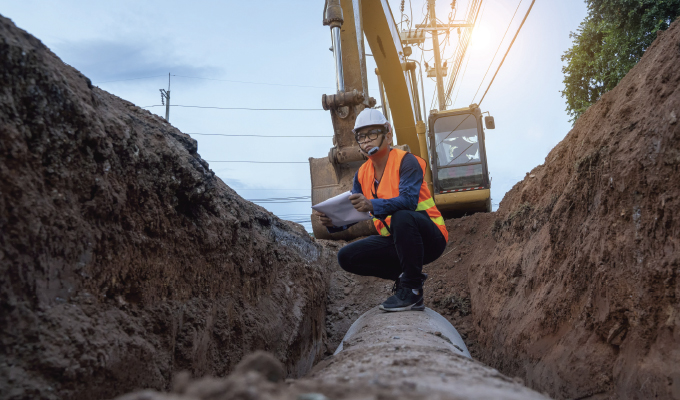Trench Safety Month is scheduled for June of 2024, and in preparation National Utility Contractors Association (NUCA) is spreading the word of best safety practices, including the importance of conducting Trench Safety Stand Downs.
NUCA is the leading trade association working solely for the utility construction and excavation industry in the United States. NUCA’s core purpose is to improve the proficiency and financial performance of its member companies by providing services that focus on shared industry issues, such as safety compliance.
WHAT IS A SAFETY STAND DOWN?
A Safety Stand Down presents the opportunity for employers to talk directly to employees and others about safety. These particular Stand Downs will focus on trench and excavation hazards and reinforce the importance of using trench protective systems and protecting workers from trenching hazards.
HOW TO CONDUCT A TRENCH SAFETY STAND DOWN
Companies will conduct a Trench Safety Stand Down by taking a break to have a toolbox talk or another safety activity to draw attention to the specific hazards related to working in and around trenches/excavations.
OSHA offers guidelines on essential safety techniques for reducing trenching and excavation hazards. Trench collapses, or cave-ins, pose the greatest risk to workers’ lives. To prevent cave-ins:
- Slope or bench the trench walls.
- Shore the trench walls with supports, or
- Shield the trench walls with trench boxes.
Employers should also ensure there is a safe way to enter and exit the trench. All materials should be kept away from the edge of the trench. Look for standing water or atmospheric hazards. Workers should never enter a trench unless it has been properly inspected. Applicable OSHA standards are 29 CFR 1926.650, 29 CFR 1926.651, and 29 CFR 1926.652.
To facilitate safety training, NUCA is asking that member companies provide to NUCA feedback about their Stand Down during Trench Safety Week, June 17-23, 2024, such as when it was held, how many workers participated, how you shared information with employees. NUCA will collect the information, publicize the overall total number of participants, and publish the names of the companies that held a Trench Safety Stand Down. Anyone who wants to prevent trenching and excavation hazards in the workplace can participate in the Stand Down. NUCA encourages participation from construction, utility, residential, highway construction, plumbers, military, unions, and more.

Safety Fundamentals:
- Locate all underground utilities before digging.
- Enter only trenches that have been sloped at the proper angle, shored, or shielded.
- Never go outside the area that has been sloped, shored, or shielded, not even for a moment.
- Eliminate or control water accumulation before entering the trench.
- Stay alert when working in or near previously disturbed soil conditions.
- Do not permit vehicles near the edge of the trench.
- Check regularly for hazardous materials and oxygen levels in the trench.
- Never allow machines to run unattended.
- Use a ladder or ramp to get in and out of the trench. Place the ladder inside the protective system.
- Never climb on shoring or shields. Never ride in equipment buckets or on crane hooks.
- Wear hard hats when working in or around trenches.
- Stay out from under raised loads.
- About half of the people killed each year in trenches die trying to rescue someone else who has been buried by a cave-in. Call 911 for help. Do not attempt a rescue unless you have been properly trained in trench-rescue techniques.
TRENCH SAFETY GUIDELINES
Working in a trench is one of the most hazardous jobs in construction, and hundreds of people die each year due to cave-ins. Soil weighs between 90 and 140 pounds per cubic foot. Therefore, one cubic yard (3 ft. by 3 ft. by 3 ft.) can weigh as much as a small pickup truck. If a person is buried, there is little chance of survival.
Many factors can affect soil stability, such as the type of soil, water, and vibration. Soils saturated with water and previously disturbed soils are very dangerous to work in or around. However, even hard soil and rock that appears stable can cave in.
Before entering a trench, the competent person at the jobsite must inspect the trench and the protection system to ensure that the trench is safe to enter. There are recorded incidents of people buried and killed in trenches 3- to 4-ft. deep, so even shallow trenches must be inspected by a competent person before entering.
For More Information:
The National Utility Contractors Association’s Toolbox Talks safety information is available free to the public at www.nuca.com.
Modern Contractor Solutions, February 2024
Did you enjoy this article?
Subscribe to the FREE Digital Edition of Modern Contractor Solutions magazine.



